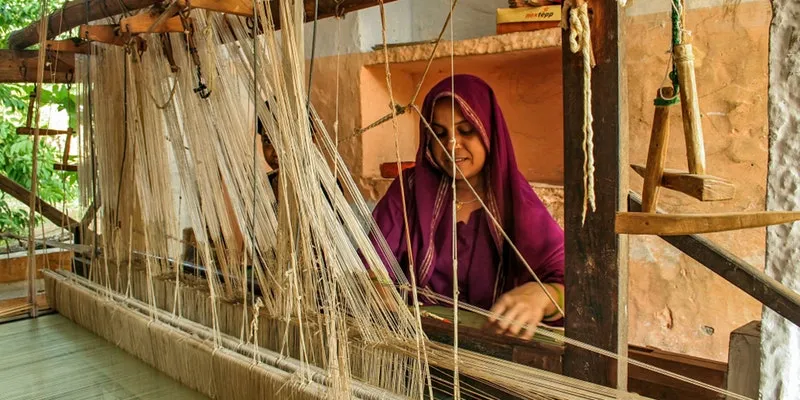Can solving the cotton crisis provide a boost to the Indian textile MSMEs?
Indian fashion and textile MSMEs have the power to take over the world. However, the challenges for the Indian fashion and textile industry seem to be far from over.
The COVID-19 pandemic has reinforced that micro, small, and medium enterprises (MSMEs) are the backbone of the Indian economy.
Especially the textile and fashion MSMEs have shown tremendous growth amidst the pandemic by overcoming supply chain challenges and embracing digital technologies.
However, the challenges for this industry in the country seem to be far from over. The world’s largest producer of cotton, India is witnessing a steep rise in domestic prices of raw cotton yarn, putting the fashion industry, especially MSMEs, at the risk of stunted growth or disruption across the textile value chain of the country.
Notably, cotton prices have risen about 65 percent from last year, which now stand at Rs 219 per kg (February 2022).
And, decreasing domestic supplies and increasing prices could add substantially to the costs of readymade garments, leading to their increased selling prices, which places the industry at a price disadvantage compared to garments produced from countries, including Bangladesh, Vietnam, etc.
What’s causing this sharp price hike?
The answer to this “big” question may be the root cause of the cotton crisis India is facing today. Generally, prices rise due to a gap in demand and supply or an increase in the complementing sectors.
Over the years, while cotton yield has dropped, the industry, on the whole, has managed to fulfill the production capacity.
Ravi Sam, Chairman of Southern India Mills’ Association, had told The Hindu that the 2021-2022 cotton season started with a comfortable opening stock of 75 lakh bales and estimated crop of 360 lakh bales. The cotton prices started increasing from the beginning.
So, a 65 percent price increase seems quite exorbitant if there is no shortage of cotton production in the country and even if we take into account the increased prices of petrol and diesel.
India may be facing the “great Indian cotton drain,” i.e., the unconstrained export of cotton. Other reasons for the skyrocketing domestic prices could be price speculations and poor cotton export and import policies.
In a statement to The Hindu Business Line, Rikhab Jain, Chairman of TT Group, had earlier said the speculators might be driving up cotton prices, alleging irregularities in domestic cotton futures and hedging in New York.

The multi-layered impact of the cotton crisis on MSMEs
As per IBEF, India’s textiles and apparel industry contributed nearly 2 percent to the country’s GDP, 12 percent to export earnings, and held 5 percent of the global trade. By 2029, the Indian textiles market is expected to be worth more than $209 billion.
However, if the textile value chain is disrupted due to the ongoing cotton crisis, it would come as a major setback for the industry on the global front because then we’ll be forced to import cheaper cotton from other countries at higher import duties, and the production costs will go up, making readymade garments expensive.
Moreover, it will lead us to lose a big chunk of revenue as we’ll miss out on the opportunity to become readymade garment export giants, despite having one of the largest textile sectors in the world.
Resolving the cotton crisis can accelerate the growth of the industry
Indian fashion and textile MSMEs have the power to take over the world. The country’s apparel industry is seeing momentous demand globally.
After reaching the record high of $106 billion in FY20, the domestic textile and apparels industry was severely impacted by the onset of COVID-19, slumping to $75 billion in 2021.
However, as the demand stabilised and continued to increase over time, the industry quickly recovered. Its indigenous textiles and art forms are fast becoming the face of luxury and sustainable fashion.
Further, several government initiatives to aid the sector have raised hopes for the sector to grow by about $300 billion by 2025-26.
In fact, a significant increase in the budget allocation for the textile sector under Union Budget 2022-2023 is proof that even the Indian government acknowledges the potential in the industry.
The budget allocation for the textile sector, presented by Finance Minister Nirmala Sitharaman earlier in February, stands at about Rs 12,382.14 crore, nearly 8.1 percent higher than last year’s budget.
The government also approved the proposal for the creation of the National Technical Textiles Mission (NTTM) within four years for Rs 1,480 crore.
Thus, realising the textile industry is at the dawn of a glorious future, the entire industry must come together, along with the government, to acknowledge the gaps causing the cotton crisis in India and resolve it.
More importantly, the industry should not make peace with exporting cotton at a small premium, but look at the big picture — to make India the new face of global fashion in the retail sector.
Edited by Suman Singh
(Disclaimer: The views and opinions expressed in this article are those of the author and do not necessarily reflect the views of YourStory.)









